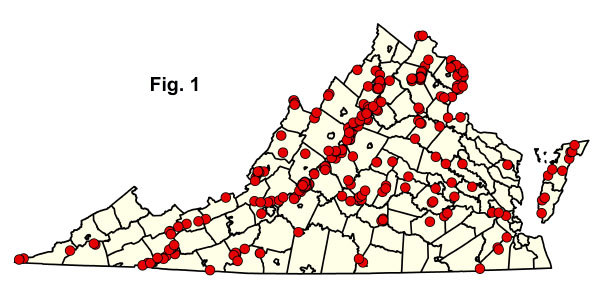
 Sở Bảo Tồn và Giải Trí
Sở Bảo Tồn và Giải Trí Bảo Tồn. Bảo Vệ. Tận Hưởng.
 Sở Bảo Tồn và Giải Trí
Sở Bảo Tồn và Giải Trí  Mục lục
Mục lụcRừng sồi / cây thạch nam
This group of oak-dominated forests is prevalent on xeric, infertile upland sites in every physiographic province of Virginia, and is wide-ranging in the Appalachians and adjacent provinces outside of the Commonwealth. In some cases, particularly in the mountains and foothills, these communities have replaced former mixed oak - American chestnut (Castanea dentata) forests following the decimation of chestnut overstory trees by an introduced fungal blight (Cryphonectria parasitica) early in the twentieth century. Habitats are variable, ranging from sterile, low-elevation "flatwoods" to steep, rocky mountainsides. All have soils with a distinctly oligotrophic nutrient regime, i.e., strongly acidic, with low base cation levels and relatively high levels of iron. Accumulations of thick duff and high biomass of inflammable shrubs in these forests make them susceptible to periodic fires, which in turn favors recruitment of oaks. Regionally varying mixtures of white oak (Quercus alba), chestnut oak (Quercus montana), scarlet oak (Quercus coccinea), black oak (Quercus velutina), northern red oak (Quercus rubra), southern red oak (Quercus falcata), and post oak (Quercus stellata) compose the overstories of these forests. Bigtooth aspen (Populus grandidentata) and pines - including pitch pine (Pinus rigida) in the mountains, shortleaf and Virginia pines (Pinus echinata and Pinus virginiana) in the Piedmont, and loblolly pine (Pinus taeda) in the Coastal Plain - are common associates that usually indicate past disturbance. Hickories (Carya spp.) are generally unimportant and, when present, mostly restricted to the understory.

Forests overwhelmingly dominated by chestnut oak (Quercus montana, = Quercus prinus) are widespread on sandstone or quartzite ridges in the mountains, but occur locally on monadnocks, foothills, and rocky or gravelly bluffs throughout the Piedmont and inner Coastal Plain. On gentler, low-elevation terrain of eastern Virginia and the mountain valleys, white oak is more prominent in mixtures with several other oaks. Blackgum (Nyssa sylvatica) and sourwood (Oxydendrum arboreum) are frequent overstory associates and abundant understory trees, along with sassafras (Sassafras albidum) and downy serviceberry (Amelanchier arborea). Decades of fire suppression or exclusion has led to a general abundance of the fire-intolerant red maple (Acer rubrum) in oak / heath forest understories. Ericaceous (heath-family) plants, including mountain laurel (Kalmia latifolia), black huckleberry (Gaylussacia baccata), wild azalea (Rhododendron periclymenoides), and blueberries (Vaccinium spp.), form dense colonies in the shrub and herb layers. Evergreen rhododendrons (Rhododendron maximum and Rhododendron catawbiense) and flame azalea (Rhododendron calendulaceum) are locally prevalent members of the ericaceous shrub complex in the mountains, while dangleberry (Gaylussacia frondosa) is a prominent ericad in the Coastal Plain. The ericaceous sub-shrubs trailing arbutus (Epigaea repens) and wintergreen (Gaultheria procumbens) may also be abundant, especially in the mountains. The density of ericaceous species may be closely tied to land-use and disturbance history. True herbaceous species are sparse, but may include scattered individuals or colonies of xerophytes such as galax (Galax urceolata), yellow wild indigo (Baptisia tinctoria), pink lady's-slipper (Cypripedium acaule), dwarf iris (Iris verna), large whorled pogonia (Isotria verticillata), cancer-root (Orobanche uniflora), gaywings (Polygaloides paucifolia), eastern bracken fern (Pteridium aquilinum ssp. latiusculum), and Virginia goat's-rue (Tephrosia virginiana).
Các loại cộng đồng trong nhóm này tạo nên một thành phần phổ biến của thảm thực vật dạng ma trận hoặc mảng lớn trong cảnh quan của Virginia. Mặc dù vẫn còn tương đối rộng lớn, nhưng chúng đang phải chịu nhiều tác động, bao gồm chặt phá rừng, chuyển đổi sang trồng rừng thông, nhiễm sâu bướm đêm, chữa cháy và phá hủy do phát triển đô thị. Tuy nhiên, một số quần thể cây sồi hạt dẻ trên các dãy núi khô ở Virginia đã không bị chặt phá vì cây còi cọc và hình dạng xấu của tán cây.
Tài liệu tham khảo: Abrams et al . (1997), Adams và Stephenson (1983), Allard và Leonard (1943), Clark và Ware (1980), Cole và Ware (1997), Coulling và Rawinski (1999), Crouch (1990), Farrell và Ware (1988), Fleming (2002a), Fleming (2002b), Fleming (2007), Fleming và Coulling (2001), Fleming và Moorhead (1996), Fleming và Moorhead (2000), Fleming và Weber (2003), Gemborys (1974), Harrison và cộng sự . (1989), Johnson và Ware (1982), Martin và cộng sự . (1982), McCoy và Fleming (2000), McEvoy và cộng sự . (1980), Olson và Hupp (1986), Orwig và Abrams (1994), Rawinski và cộng sự . (1994), Rawinski và cộng sự . (1996), Rhoades (1992), Rhoades (1995), Rhoades (2002), Stephenson (1974), Stephenson (1982a), Stephenson và Adams (1991), Stephenson và Fortney (1998), Vanderhorst (2000), Walton và cộng sự (2001), Ware (1991).Nhấp vào đây để xem thêm ảnh về nhóm cộng đồng sinh thái này.
 © DCR-DNH, Gary P. Fleming.
© DCR-DNH, Gary P. Fleming.
Hơn 300 lô thảm thực vật này đã được lấy mẫu ở Virginia (Hình 1) và chín loại cộng đồng đã được phân loại trong quá trình phân tích khu vực. Hầu hết các đơn vị cấp độ chi tiết hơn này được phân biệt rõ ràng bằng sự khác biệt lớn về độ cao/địa lý và hệ thực vật liên quan. Tuy nhiên, sự tách biệt được cho là của các đơn vị "Trung Appalachia" và "Nam Appalachia" đặc biệt gây ra nhiều vấn đề ở phía tây Virginia, nơi hệ thực vật của các vùng sinh học địa lý này thường hòa trộn một cách vô thức. Nhấp vào bất kỳ mã CEGL nào được tô sáng bên dưới để xem mô tả USNVC toàn cầu do NatureServe Explorer cung cấp. 
 Tải xuống bảng tính thống kê tóm tắt thành phần cho từng loại cộng đồng được liệt kê bên dưới.
Tải xuống bảng tính thống kê tóm tắt thành phần cho từng loại cộng đồng được liệt kê bên dưới.

